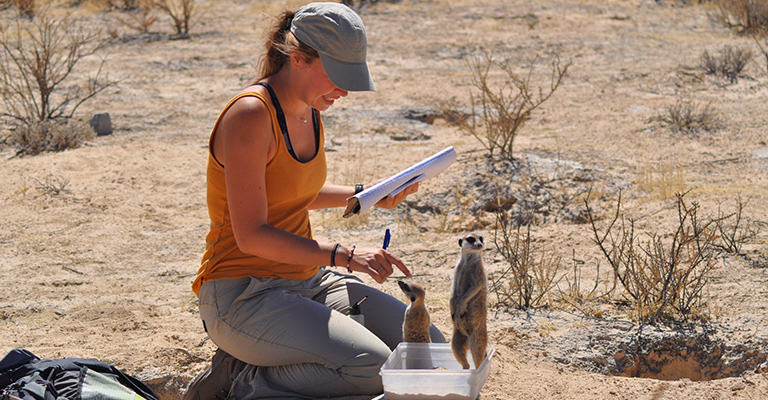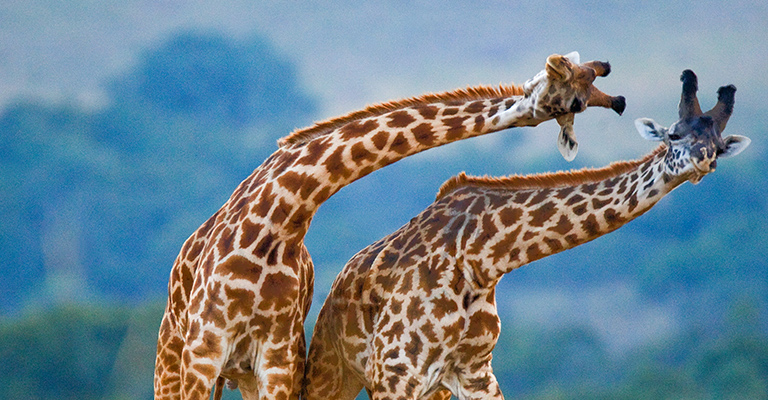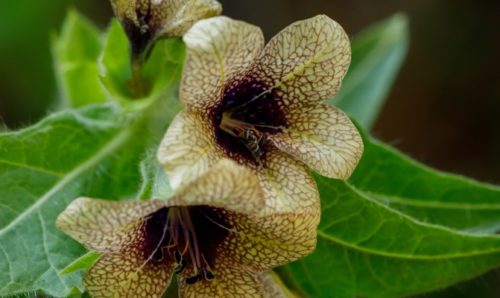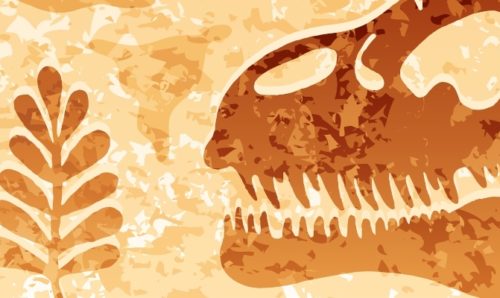Neck and neck: The ‘gentleman etiquette’ of sparring giraffes
Departments Research impact and institutes 5th May 2022
Fighting fair might be a tall order for some – but not, it seems, for giraffes.
According to neck-xtraordinary research, spotted and shared by news outlets around the globe, the world’s tallest mammals are typically honourable when sparring; picking on giraffes their own size, and even respecting each other’s preference for right or left-sided combat.
Collected by Manchester PhD candidate Jessica Granweiler at the Mogalakwena Research Centre in South Africa, while on a placement year as part of her undergraduate studies in the Department of Earth and Environmental Sciences, the findings have been picked up by the Times, the New York Times, CBC, and more.
And, as Jessica tells us, such long-reaching coverage can provide a (tall) leg up for her overarching aim: to highlight the – very serious – plight of giraffes in Africa.

Fighting for survival
“Giraffes are in great decline across Africa – and are in much worse shape than elephants or other species that one thinks about when considering species to conserve,” she explains.
“So by getting the public and other researchers involved, we can raise interest and awareness for this iconic species – and hopefully increase the research and conservation effort in the near future.”
And it appears to be working. Of the press coverage, she says: “I was actually quite shocked but also delighted. After publishing my results I really wanted to get the word out there, so that other researchers would pick up on my work and try to replicate my research on other populations.
“I am also glad that the press was able to get the message across to the greater public. Giraffes are not as well studied as we would imagine, although the past few years have seen a great research effort to try and bridge that gap.”
Pains in the neck
So, what do the findings show?
“Firstly,” Jessica notes, “I should clarify that sparring looks similar to fighting, with the swinging of the neck to hit each other with their ossicones, but it does not possess the intensity and motive that fighting does. In sparring the movements are soft and do not aim to hurt the opponent, whereas fighting is a very brief and violent interaction where at least one of the opponents gets injured.
“Because not much information was available in the literature about sparring behaviour in giraffes, I started my research project with the basics. I looked at which males took part in the most sparring; was it a particular age class? Or specific individuals? Was it linked to any place in the dominance hierarchy? Are there any preferences in who they spar with?
“My results showed that younger males took part in more sparring events, but that older males take part in longer sparring matches, which I could associate with a dual function of sparring as training for the younger males and an opportunity to compare themselves to others for older males, without incurring the costs of actual fighting. Additionally, I found that males most often choose a sparring partner that is of similar size and age.
“But I guess the most novel result I found was that each male had a preferred side to spar on, similarly to being left or right-handed, and that both individuals respected each other’s preferred side in every interaction.”

Giraffe-ter the fact
Jessica is hopeful her work will inspire others in the field to follow suit – and investigate similar behaviours in other giraffe populations.
“I believe that sparring could be used as an indicator of social stress and forced interactions between males in areas of high density,” she continues. “In that males that cannot avoid each other and encounter each other at a greater frequency than wished for, could take part in sparring to resolve some social tension, instead of taking part in costly fights.
“If this proves to be correct, sparring studies would bring crucial information when it comes to managing and conserving giraffe populations across Africa.”
Of her time in South Africa, she adds: “I loved being able to design my project completely, from the questions to the methods and data collection. I also enjoyed spending so much time in the field, which is how I decided on most of my questions, including the focus on sparring behaviour.
“I decided to focus on this topic as I kept seeing the males sparring together, and therefore assumed it must have an important role in their social dynamics. To have been able to publish my research, albeit a few years later, is something I am very proud of and for me symbolises the fact that this is what I want to do for my career, and that I am not too bad at it!”
On the move
Now in the first year of her PhD at Manchester in Environmental Sciences, Jessica is continuing her focus on giraffes – this time on their behavioural ecology.
“More specifically, my project aims to investigate differences and patterns in behaviour, social networks, space use and stress hormones across a landscape that varies in levels of human densities, lion predation and vegetation quality in the reticulated giraffe population, in the Laikipia region in Kenya.
“I am interested in the possible trade-offs that this population has to endure by living and moving across a landscape in which they need to find the best sources of food, while still avoiding areas with high predation and human interaction.
“However, the latter might not always be possible or could be in contradiction with getting access to the best food spots, and I research how they make those decisions and what factors, or combination of factors, matter the most, and if this differs across sex and age groups.
“Giraffes are known to be incredibly flexible in their behaviour in order to adapt to cues and pressures in their environment, which I find very interesting and hope to bring more answers as to how giraffes view different aspects and pressures in their environment, and how they respond to it.”
It all sounds promising to us – and a long stride in the right direction.
Hopefully, these stately animals will be given the fighting chance they deserve.
If you enjoyed this post, be sure to subscribe on our homepage to keep up to date with the latest posts from The Hub.
Words: Joe Shervin
Images: Shutterstock, Jessica Granweiler




